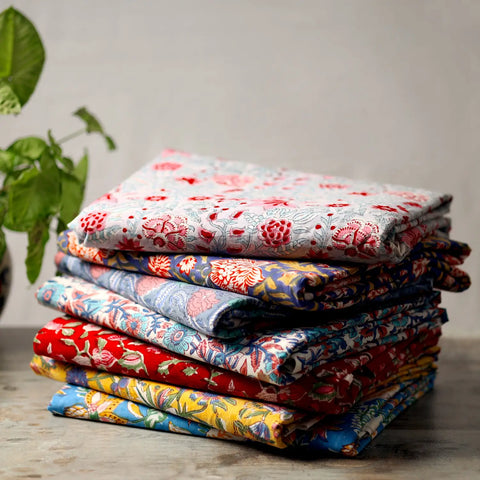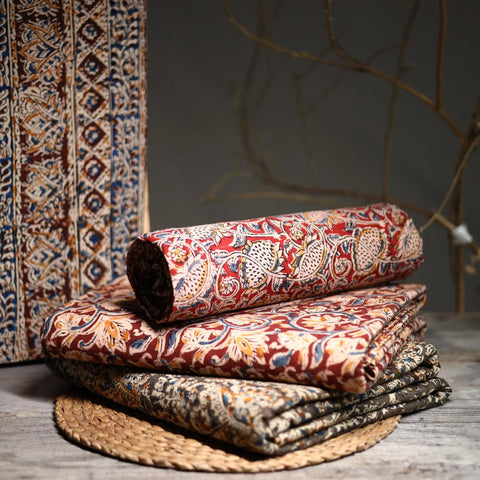India, a land of vibrant colours, diverse cultures, and rich traditions, has a fascinating story to tell through its handcrafted fabrics. These fabrics are not just pieces of cloth but are woven with threads of history, culture, and the unique craftsmanship of skilled artisans. Let’s dive into the world of handcrafted fabric collections and explore their cultural significance in traditional Indian attire.

The Charm of Handcrafted Fabrics
Have you ever wondered why handcrafted fabrics hold such a special place in our hearts? It's not just about the intricate designs or the vibrant colours; it's about the human touch, the stories behind each weave, and the traditions passed down through generations.
The Human Touch
Handcrafted fabrics are a labour of love. Unlike machine-made textiles, each piece of handcrafted fabric involves the meticulous effort of artisans. These skilled craftsmen and women pour their heart and soul into every thread, ensuring that each piece is unique. This human touch adds an element of authenticity and warmth to the fabric, making it truly special.
Stories Behind the Weave
Every handcrafted fabric tells a story. Whether it's a piece of Banarasi silk or a Pashmina shawl, there’s a rich history and a cultural narrative woven into the fabric. These stories often reflect the local traditions, the environment, and the way of life of the people who create them. Wearing these fabrics is like wrapping yourself in a piece of history and culture.
Traditional Attire and Handcrafted Fabrics
Traditional Indian attire is incomplete without the elegance and beauty of handcrafted fabrics. From sarees and lehengas to kurta-pajamas and dupattas, handcrafted fabrics play a vital role in Indian fashion.
Sarees
The saree is perhaps the most iconic piece of traditional Indian attire, and handcrafted sarees are a sign of elegance. Each region in India has its unique style of saree, often characterised by distinct weaving techniques and patterns. For instance, the Kanjivaram sarees from Tamil Nadu are known for their rich silk and intricate zari work, while the Bandhani sarees from Gujarat are famous for their vibrant tie-dye patterns.
Lehengas and Cholis
Lehengas and cholis, often worn during weddings and festivals, are another example of traditional attire that showcases the beauty of handcrafted fabrics. These garments are usually adorned with elaborate embroidery, mirror work, and beadwork, all done by hand. The meticulous craftsmanship adds a touch of opulence and grandeur to the attire.
Kurtas and Dupattas
Handcrafted fabrics are not just reserved for special occasions. Kurtas and dupattas made from handwoven cotton, silk, or wool are a staple in everyday Indian fashion. The comfort and elegance of these fabrics make them perfect for daily wear, while the unique designs and patterns add a touch of sophistication to any outfit.
The Cultural Significance
Handcrafted Fabric Collections are deeply intertwined with the cultural fabric of India. They are a reflection of the country’s diverse heritage and play a significant role in various cultural and religious traditions.
Festivals and Rituals
In India, festivals and rituals are often celebrated with traditional attire made from handcrafted fabrics. During Diwali, women adorn themselves in beautiful silk sarees, while men wear traditional kurta-pajamas. The fabric and design of these garments are often chosen to reflect the festive spirit and the cultural significance of the occasion.
Weddings: A Celebration of Tradition
Weddings in India are grand affairs, and traditional attire made from handcrafted fabrics is an integral part of the celebrations. The bride’s trousseau often includes a variety of handcrafted sarees and lehengas, each representing different cultural traditions. The intricate designs and rich textures of these fabrics symbolise the opulence and grandeur of Indian weddings.
Everyday Life and Identity
Handcrafted fabrics are not just for special occasions; they are an essential part of everyday life in India. They represent the cultural identity and heritage of different regions. For example, the handwoven Ikat fabrics from Odisha are known for their distinctive patterns and vibrant colours, reflecting the state’s rich cultural heritage.
The Artisans Behind the Magic
Behind every piece of handcrafted fabric collection is a skilled artisan who has spent years honing their craft. These artisans are the true custodians of India’s textile heritage.
Preserving Traditional Techniques
Many of the techniques used to create handcrafted fabrics have been passed down through generations. Artisans often learn their craft from their parents and grandparents, preserving traditional techniques and ensuring that they are not lost to time. Techniques such as block printing, hand embroidery, and weaving are kept alive through the dedication and hard work of these craftsmen and women.
Challenges Faced by Artisans
Despite their invaluable contribution to India’s cultural heritage, artisans often face numerous challenges. Many struggle with low wages, lack of recognition, and competition from machine-made textiles. However, initiatives to promote handcrafted fabrics and fair trade practices are helping to improve their livelihoods and preserve their craft.
The Modern Revival
In recent years, there has been a renewed interest in handcrafted fabrics. Fashion designers and consumers alike are recognising the value of sustainable and ethical fashion, leading to a resurgence in the popularity of handcrafted textiles.
Sustainable and Ethical Fashion
Handcrafted fabrics are a sustainable and ethical alternative to mass-produced textiles. They are made using traditional methods that have a lower environmental impact and often use natural dyes and fibres. By choosing handcrafted fabrics, consumers can support sustainable fashion and promote the livelihoods of artisans.
Fashion and Innovation
Modern fashion designers are incorporating handcrafted fabrics into their collections, blending traditional techniques with contemporary designs. This fusion of old and new creates unique and innovative fashion pieces that appeal to a global audience. The versatility and beauty of handcrafted fabrics make them perfect for both traditional and modern styles.
Embracing Handcrafted Fabrics
So, how can you incorporate handcrafted fabrics into your wardrobe and support this beautiful tradition?
Start with Basics
Begin by adding a few handcrafted pieces to your wardrobe. A handwoven cotton kurta or a silk dupatta can add a touch of elegance to your everyday outfits.
Invest in Statement Pieces
For special occasions, invest in statement pieces such as a handcrafted saree or lehenga. These garments are timeless and can be cherished for years to come.
Support Artisan Communities
By purchasing handcrafted fabrics, you are directly supporting the artisans who create them. Look for fair trade and ethically made products to ensure that your purchase benefits the craftsmen and women.

Bottom Line
Handcrafted fabric collections hold immense cultural significance in traditional Indian attire. They are a testament to the rich heritage and skilled craftsmanship of India’s artisans. By embracing handcrafted fabrics, we celebrate our cultural heritage and support sustainable and ethical fashion. So, next time you shop for traditional attire, consider the stories, traditions, and artisans behind the fabric, and make a choice that honors the beauty and history of handcrafted textiles. iTokri offers a range of exquisite sarees, lehengas, and kurtas that reflect the beauty and diversity of Indian textiles. Explore iTokri to get a curated collection of handcrafted fabric collections.
 Verified Purchase
Verified Purchase






















































































Leave a comment (all fields required)